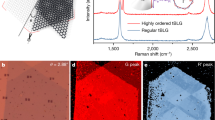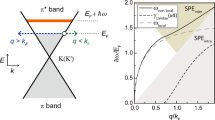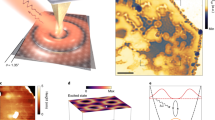Abstract
Layer-stacking domain walls in bilayer graphene are emerging as a fascinating one-dimensional system1,2,3,4,5,6,7,8,9,10,11 that features stacking solitons1,2,3,4 structurally and quantum valley Hall boundary states5,6,7,8,9,10,11 electronically. The interactions between electrons in the 2D graphene domains and the one-dimensional domain-wall solitons can lead to further new quantum phenomena. Domain-wall solitons of varied local structures exist along different crystallographic orientations1,2,12,13, which can exhibit distinct electrical, mechanical and optical properties. Here we report soliton-dependent 2D graphene plasmon reflection at different 1D domain-wall solitons in bilayer graphene using near-field infrared nanoscopy. We observe various domain-wall structures in mechanically exfoliated graphene bilayers, including network-forming triangular lattices, individual straight or bent lines, and even closed circles. The near-field infrared contrast of domain-wall solitons arises from plasmon reflection at domain walls, and exhibits markedly different behaviours at the tensile- and shear-type domain-wall solitons. In addition, the plasmon reflection at domain walls exhibits a peculiar dependence on electrostatic gating. Our study demonstrates the unusual and tunable coupling between 2D graphene plasmons and domain-wall solitons.
This is a preview of subscription content, access via your institution
Access options
Subscribe to this journal
Receive 12 print issues and online access
$259.00 per year
only $21.58 per issue
Buy this article
- Purchase on Springer Link
- Instant access to full article PDF
Prices may be subject to local taxes which are calculated during checkout




Similar content being viewed by others
References
Alden, J. S. et al. Strain solitons and topological defects in bilayer graphene. Proc. Natl Acad. Sci. USA 110, 11256–11260 (2013).
Butz, B. et al. Dislocations in bilayer graphene. Nature 505, 533–537 (2014).
Yankowitz, M. et al. Electric field control of soliton motion and stacking in trilayer graphene. Nature Mater. 13, 786–789 (2014).
Lin, J. H. et al. AC/AB stacking boundaries in bilayer graphene. Nano Lett. 13, 3262–3268 (2013).
Yao, W., Yang, S. A. & Niu, Q. Edge states in graphene: from gapped flat-band to gapless chiral modes. Phys. Rev. Lett. 102, 096801 (2009).
Ju, L. et al. Topological valley transport at bilayer graphene domain walls. Nature 520, 650–655 (2015).
Zhang, F., Jung, J., Fiete, G. A., Niu, Q. & MacDonald, A. H. Spontaneous quantum Hall states in chirally stacked few-layer graphene systems. Phys. Rev. Lett. 106, 156801 (2011).
Martin, I., Blanter, Y. M. & Morpurgo, A. F. Topological confinement in bilayer graphene. Phys. Rev. Lett. 100, 036804 (2008).
Zhang, F., MacDonald, A. H. & Mele, E. J. Valley Chern numbers and boundary modes in gapped bilayer graphene. Proc. Natl Acad. Sci. USA 110, 10546–10551 (2013).
Vaezi, A., Liang, Y. F., Ngai, D. H., Yang, L. & Kim, E.-A. Topological edge states at a tilt boundary in gated multilayer graphene. Phys. Rev. X 3, 021018 (2013).
Semenoff, G. W., Semenoff, V. & Zhou, F. Domain walls in gapped graphene. Phys. Rev. Lett. 101, 087204 (2008).
Hattendorf, S., Georgi, A., Liebmann, M. & Morgenstern, M. Networks of ABA and ABC stacked graphene on mica observed by scanning tunneling microscopy. Surf. Sci. 610, 53–58 (2013).
Lalmi, B. et al. Flower-shaped domains and wrinkles in trilayer epitaxial graphene on silicon carbide. Sci. Rep. 4, 4066 (2014).
Oostinga, J. B., Heersche, H. B., Liu, X. L., Morpurgo, A. F. & Vandersypen, L. M. K. Gate-induced insulating state in bilayer graphene devices. Nature Mater. 7, 151–157 (2008).
Dean, C. R. et al. Hofstadter’s butterfly and the fractal quantum Hall effect in moire superlattices. Nature 497, 598–602 (2013).
Velasco, J. Jr et al. Transport spectroscopy of symmetry-broken insulating states in bilayer graphene. Nature Nanotech. 7, 156–160 (2012).
Novoselov, K. S. et al. Unconventional quantum Hall effect and Berry’s phase of 2π in bilayer graphene. Nature Phys. 2, 177–180 (2006).
Zhang, Y. et al. Direct observation of a widely tunable bandgap in bilayer graphene. Nature 459, 820–823 (2009).
Mak, K. F., Lui, C. H., Shan, J. & Heinz, T. F. Observation of an electric-field-induced band gap in bilayer graphene by infrared spectroscopy. Phys. Rev. Lett. 102, 256405 (2009).
Yang, L., Deslippe, J., Park, C.-H., Cohen, M. L. & Louie, S. G. Excitonic effects on the optical response of graphene and bilayer graphene. Phys. Rev. Lett. 103, 186802 (2009).
Aoki, M. & Amawashi, H. Dependence of band structures on stacking and field in layered graphene. Solid State Commun. 142, 123–127 (2007).
Keilmann, F. & Hillenbrand, R. Near-field microscopy by elastic light scattering from a tip. Phil. Trans. R. Soc. A 362, 787–805 (2004).
Novotny, L. & Hecht, B. Principles of Nano-Optics (Cambridge Univ. Press, 2006).
Bechtel, H. A. et al. Ultrabroadband infrared nanospectroscopic imaging. Proc. Natl Acad. Sci. USA 111, 7191–7196 (2014).
Gerber, J. A., Berweger, S., O’Callahan, B. T. & Raschke, M. B. Phase-resolved surface plasmon interferometry of graphene. Phys. Rev. Lett. 113, 055502 (2014).
Fei, Z. et al. Electronic and plasmonic phenomena at graphene grain boundaries. Nature Nanotech. 8, 821–825 (2013).
Hwang, E. H. & Das Sarma, S. Dielectric function, screening, and plasmons in two-dimensional graphene. Phys. Rev. B 75, 205418 (2007).
Fei, Z. et al. Gate-tuning of graphene plasmons revealed by infrared nano-imaging. Nature 487, 82–85 (2012).
Chen, J. et al. Optical nano-imaging of gate-tunable graphene plasmons. Nature 487, 77–81 (2012).
Ju, L. et al. Graphene plasmonics for tunable terahertz metamaterials. Nature Nanotech. 6, 630–634 (2011).
Yan, H. et al. Tunable infrared plasmonic devices using graphene/insulator stacks. Nature Nanotech. 7, 330–334 (2012).
Novoselov, K. S. et al. Electric field effect in atomically thin carbon films. Science 306, 666–669 (2004).
Acknowledgements
The near-field infrared nanoscopy measurements and plasmon analysis are supported by the Office of Basic Energy Science, Department of Energy under contract No. DE-AC02-05CH11231 (Sub-wavelength Metamaterial programme). The bilayer graphene domain-wall sample preparation and characterization are supported by the Office of Naval Research award No. N00014-15-1-2651 (device fabrication and characterization) and the National Science Foundation award No. DMR-1206512 (sample preparation). L.Jiang acknowledges support from the Chinese Academy of Sciences. T.J. acknowledges support from the NSF Graduate Research Fellowship Program under Grant No. DGE 1106400.
Author information
Authors and Affiliations
Contributions
F.W. and Z.S. conceived the project. L.Jiang, Z.S., T.J., B.Z. and L.Ju performed the near-field infrared measurements. C.J. and J.K. prepared the samples. L.Jiang, Z.S., S.W., J.-H.K., T.L. and F.W. analyse the data. All authors discussed the results and contributed to writing the manuscript.
Corresponding author
Ethics declarations
Competing interests
The authors declare no competing financial interests.
Supplementary information
Supplementary Information
Supplementary Information (PDF 458 kb)
Rights and permissions
About this article
Cite this article
Jiang, L., Shi, Z., Zeng, B. et al. Soliton-dependent plasmon reflection at bilayer graphene domain walls. Nature Mater 15, 840–844 (2016). https://doi.org/10.1038/nmat4653
Received:
Accepted:
Published:
Issue Date:
DOI: https://doi.org/10.1038/nmat4653
This article is cited by
-
Twisted moiré conductive thermal metasurface
Nature Communications (2024)
-
Plasmonic sensors based on graphene and graphene hybrid materials
Nano Convergence (2022)
-
Active control of micrometer plasmon propagation in suspended graphene
Nature Communications (2022)
-
Manipulating polaritons at the extreme scale in van der Waals materials
Nature Reviews Physics (2022)
-
Unconventional non-local relaxation dynamics in a twisted trilayer graphene moiré superlattice
Nature Communications (2022)



